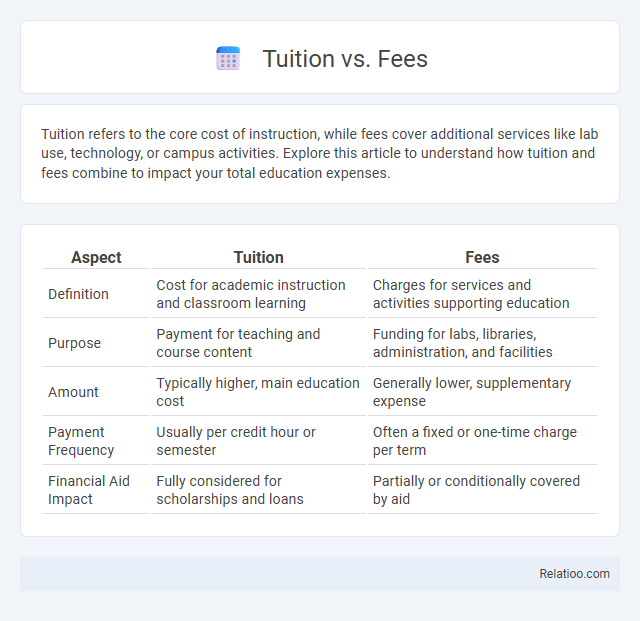Tuition refers to the core cost of instruction, while fees cover additional services like lab use, technology, or campus activities. Explore this article to understand how tuition and fees combine to impact your total education expenses.
Table of Comparison
| Aspect | Tuition | Fees |
|---|---|---|
| Definition | Cost for academic instruction and classroom learning | Charges for services and activities supporting education |
| Purpose | Payment for teaching and course content | Funding for labs, libraries, administration, and facilities |
| Amount | Typically higher, main education cost | Generally lower, supplementary expense |
| Payment Frequency | Usually per credit hour or semester | Often a fixed or one-time charge per term |
| Financial Aid Impact | Fully considered for scholarships and loans | Partially or conditionally covered by aid |
Understanding Tuition and Fees
Tuition refers to the fixed amount charged by educational institutions for instruction or academic courses, while fees encompass additional charges for services such as lab access, technology, and activity participation. Understanding the distinction between tuition and fees is crucial for accurate financial planning and managing overall education costs. Clear awareness of these components helps students anticipate expenses beyond the base tuition, ensuring a comprehensive budget for their academic investment.
Key Differences Between Tuition and Fees
Tuition refers to the core cost charged for instruction and educational services, typically calculated per credit hour or semester. Fees encompass additional mandatory charges covering campus services like libraries, technology, and extracurricular activities, separate from instructional costs. Understanding these distinctions helps students budget accurately by recognizing that tuition covers academic instruction while fees fund essential non-instructional resources.
What Does Tuition Typically Cover?
Tuition typically covers the core academic instruction provided by an educational institution, including costs associated with faculty salaries, classroom resources, and curriculum development. Fees, in contrast, often refer to additional charges for services such as lab access, technology, student activities, and administrative support. Understanding the distinction helps students budget accurately, as tuition covers essential education expenses while fees fund supplementary campus resources and facilities.
Common Types of Fees in Education
Tuition covers the cost of instruction and is the primary expense for Your education, while fees include additional charges such as registration, laboratory, technology, and activity fees that support specific services and facilities. Common types of fees often cover student health services, campus maintenance, library access, and extracurricular programs, which supplement but are separate from tuition costs. Understanding these distinctions helps You budget effectively and anticipate the full financial commitment required for educational institutions.
Why Are Fees Charged Separately?
Fees are charged separately from tuition to cover specific services and facilities that are not included in the basic cost of instruction, such as campus maintenance, technology resources, and student activities. Unlike tuition, which primarily funds faculty salaries and academic programs, fees ensure the sustained operation of essential support services that enhance the overall educational experience. This separation allows institutions to transparently allocate costs and manage resources effectively to meet diverse student needs.
Tuition and Fees: Impact on Total Cost
Tuition represents the primary charge for academic instruction, while fees cover supplementary services like labs, technology, and student activities, both significantly influencing your total cost of attendance. Understanding the distinction between tuition and fees helps you accurately assess the full financial commitment of your education. Colleges often list tuition and fees separately, but combined they form the comprehensive expense that you must plan for.
Hidden Costs Beyond Tuition
Tuition covers the basic cost of instruction, while fees include extras like technology, lab materials, and activity access that can significantly increase your total expenses. Hidden costs beyond tuition often involve textbooks, parking permits, and health services that many students overlook. Understanding these additional fees helps you budget more accurately and avoid unexpected financial strain during your studies.
How Institutions Set Tuition and Fees
Institutions set tuition based on factors like academic program costs, faculty salaries, and desired investment in campus facilities, aiming to balance quality education with market demand. Fees are established separately to cover specific services such as technology support, student activities, and health services, reflecting the actual cost of providing these resources. Tuition typically covers direct instructional expenses, while fees address auxiliary services, both crafted to sustain institutional operations and enhance the student experience.
Ways to Manage Tuition and Fees
Managing tuition and fees effectively requires proactive budgeting and exploring available financial aid options such as scholarships, grants, and student loans. Utilizing payment plans offered by many institutions can help spread the cost over the semester, reducing financial strain. Regularly reviewing the breakdown of tuition and fees ensures students understand and control their expenses while seeking cost-saving opportunities like in-state tuition or tuition waivers.
Comparing Tuition vs Fees Across Institutions
Tuition primarily covers the core academic instruction costs, while fees encompass additional services such as labs, technology, and student activities, varying significantly across institutions. Public universities often charge lower tuition but may have higher mandatory fees compared to private colleges, which tend to bundle costs into a single tuition rate. Understanding the breakdown between tuition and fees helps students accurately estimate total educational expenses and compare affordability between different schools.

Infographic: Tuition vs Fees
 relatioo.com
relatioo.com